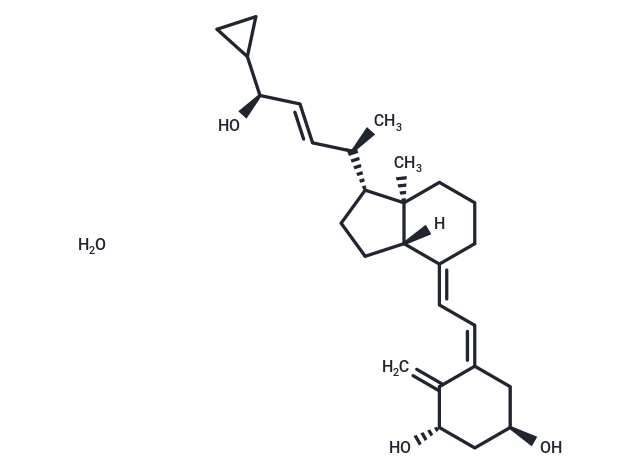Shopping Cart
- Remove All
 Your shopping cart is currently empty
Your shopping cart is currently empty

Calcipotriol monohydrate is an analog of Vitamin D3 with a high affinity for the vitamin D receptor. Calcipotriol monohydrate can be used for studies about psoriasis.

| Pack Size | Price | Availability | Quantity |
|---|---|---|---|
| 5 mg | $47 | In Stock | |
| 10 mg | $67 | In Stock | |
| 25 mg | $129 | In Stock | |
| 50 mg | $237 | In Stock | |
| 100 mg | $437 | In Stock |
| Description | Calcipotriol monohydrate is an analog of Vitamin D3 with a high affinity for the vitamin D receptor. Calcipotriol monohydrate can be used for studies about psoriasis. |
| In vitro | Calcipotriol monohydrate (100, 10, and 1 ng/mL) significantly upregulated the expression of NKp30 on the surface of NK cells after 4 h incubation[1]. When NHEK cells are not stimulated with IL-17A or IL-22, Calcipotriol monohydrate slightly enhances (0.2 nM) IL-8 mRNA expression or has no effect (2-20 nM). The addition of IL-17A and IL-22 markedly increased the mRNA expression of IL-8, confirming our previous study. This enhanced IL-8 mRNA expression is suppressed by Calcipotriol monohydrate (2, 20 and 40 nM) in a dose dependent manner[2]. |
| In vivo | The weight gain is significantly smaller in the groups treated with Diclofenac plus Calcipotriol monohydrate (p=0.018) and Diclofenac plus DFMO plus Calcipotriol monohydrate (p=0.002) compare with placebo (linear regression model)[3]. |
| Cell Research | Normal human epidermal keratinocytes are grown in serum-free keratinocyte growth medium Epilife and used at the third passage in all experiments. The growth supplement is omitted 48 h before experiments. As a control, IL-17A and IL-22 are either added or not added to the cells. Cultured NHEK cells are stimulated with IL-17A (200 ng/mL) and/or IL-22 (200 ng/mL) followed by co-incubation in the presence or absence of Calcipotriol at 0.2-40 nM to test its modulatory effect. Cells are harvested 3 days later and subjected to real-time qPCR. Culture supernatants are also collected and frozen at -80°C until used for ELISA [1]. |
| Animal Research | The 160 female SKH-1 hairless mice (6-7 weeks of age) are used. After UV treatment, mice without tumors are randomly divided into five groups, four chemoprevention groups (Diclofenac plus DFMO; Diclofenac plus Calcipotriol; DFMO plus calcitriol; and Diclofenac plus DFMO plus Calcipotriol) and one placebo group (skin lotion). The mice are treated with test mixtures once a day, five days a week, for a total of 17 weeks. The test mixtures are applied topically on the dorsal surface of the mice. Ten microliters are applied by a pipette after which the mixture is rubbed onto the skin. This corresponded to the following doses of each active substance in the treatments: 100 μg/week for Diclofenac (30 mg/g undiluted), 0.166 μg/week for Calcitriol (50 μg/g undiluted), and 463.3 μg/week for DFMO (139 mg/g undiluted) [3]. |
| Molecular Weight | 430.62 |
| Formula | C27H42O4 |
| Cas No. | 147657-22-5 |
| Smiles | O.[H][C@@]12CC[C@H]([C@H](C)\C=C\[C@@H](O)C3CC3)[C@@]1(C)CCC\C2=C/C=C1/C[C@@H](O)C[C@H](O)C1=C |
| Relative Density. | no data available |
| Storage | Powder: -20°C for 3 years | In solvent: -80°C for 1 year | Shipping with blue ice. | |||||||||||||||||||||||||||||||||||
| Solubility Information | Ethanol: 95 mg/mL (220.61 mM), Sonication is recommended. DMSO: 95 mg/mL (220.61 mM), Sonication is recommended. | |||||||||||||||||||||||||||||||||||
Solution Preparation Table | ||||||||||||||||||||||||||||||||||||
Ethanol/DMSO
| ||||||||||||||||||||||||||||||||||||

Copyright © 2015-2024 TargetMol Chemicals Inc. All Rights Reserved.